The ASUS Z170-A Motherboard Review: The $165 Focal Point
by Ian Cutress on October 20, 2015 2:00 PM EST- Posted in
- Motherboards
- Asus
- ATX
- Skylake
- Z170
System Performance
Not all motherboards are created equal. On the face of it, they should all perform the same and differ only in the functionality they provide - however this is not the case. The obvious pointers are power consumption, but also the ability for the manufacturer to optimize USB speed, audio quality (based on audio codec), POST time and latency. This can come down to manufacturing process and prowess, so these are tested.
Power Consumption
Power consumption was tested on the system while in a single MSI GTX 770 Lightning GPU configuration with a wall meter connected to the OCZ 1250W power supply. This power supply is Gold rated, and as I am in the UK on a 230-240 V supply, leads to ~75% efficiency > 50W, and 90%+ efficiency at 250W, suitable for both idle and multi-GPU loading. This method of power reading allows us to compare the power management of the UEFI and the board to supply components with power under load, and includes typical PSU losses due to efficiency. These are the real world values that consumers may expect from a typical system (minus the monitor) using this motherboard.
While this method for power measurement may not be ideal, and you feel these numbers are not representative due to the high wattage power supply being used (we use the same PSU to remain consistent over a series of reviews, and the fact that some boards on our test bed get tested with three or four high powered GPUs), the important point to take away is the relationship between the numbers. These boards are all under the same conditions, and thus the differences between them should be easy to spot.
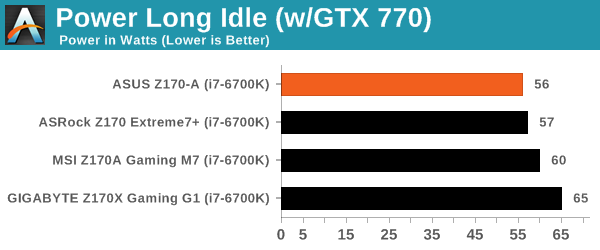
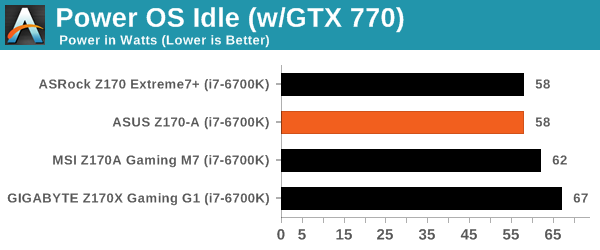
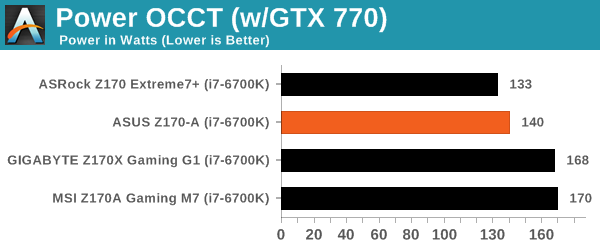
The power profile of the ASUS Z170-A when idle and loaded does well, but it is worth noting here that with these motherboards, those that implement a form of MultiCore Turbo on the K series processors also seem to increase the voltage, especially at load.
Non UEFI POST Time
Different motherboards have different POST sequences before an operating system is initialized. A lot of this is dependent on the board itself, and POST boot time is determined by the controllers on board (and the sequence of how those extras are organized). As part of our testing, we look at the POST Boot Time using a stopwatch. This is the time from pressing the ON button on the computer to when Windows 7 starts loading. (We discount Windows loading as it is highly variable given Windows specific features.)
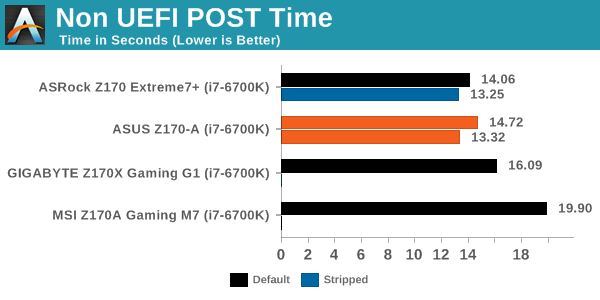
We're still in the early days for non-UEFI POST time optimization, but at this point in testing a sub-15 second result seems to be what to aim for.
Rightmark Audio Analyzer 6.2.5
Rightmark:AA indicates how well the sound system is built and isolated from electrical interference (either internally or externally). For this test we connect the Line Out to the Line In using a short six inch 3.5mm to 3.5mm high-quality jack, turn the OS speaker volume to 100%, and run the Rightmark default test suite at 192 kHz, 24-bit. The OS is tuned to 192 kHz/24-bit input and output, and the Line-In volume is adjusted until we have the best RMAA value in the mini-pretest. We look specifically at the Dynamic Range of the audio codec used on board, as well as the Total Harmonic Distortion + Noise.
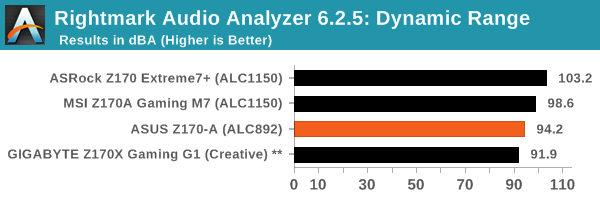
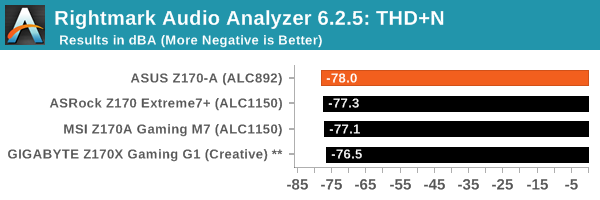
ASUS' use of the ALC892 naturally gives it an SNR disadvantage for dynamic range, but we see it do well in the distortion plus noise test.
USB Backup
For this benchmark, we transfer a set size of files from the SSD to the USB drive using DiskBench, which monitors the time taken to transfer. The files transferred are a 1.52 GB set of 2867 files across 320 folders – 95% of these files are small typical website files, and the rest (90% of the size) are small 30 second HD videos. In an update to pre-Z87 testing, we also run MaxCPU to load up one of the threads during the test which improves general performance up to 15% by causing all the internal pathways to run at full speed.
Due to the introduction of USB 3.1, as of June 2015 we are adjusting our test to use a dual mSATA USB 3.1 Type-C device which should be capable of saturating both USB 3.0 and USB 3.1 connections. We still use the same data set as before, but now use the new device. Results are shown as seconds taken to complete the data transfer.
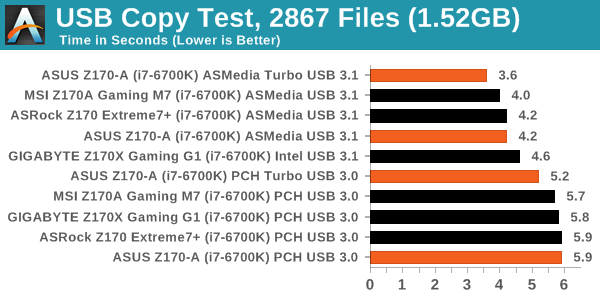
ASUS' use of Turbo drivers puts it at the top of the list for USB 3.0 and USB 3.1, although the stock speeds fall near the bottom in our small sample.
DPC Latency
Deferred Procedure Call latency is a way in which Windows handles interrupt servicing. In order to wait for a processor to acknowledge the request, the system will queue all interrupt requests by priority. Critical interrupts will be handled as soon as possible, whereas lesser priority requests such as audio will be further down the line. If the audio device requires data, it will have to wait until the request is processed before the buffer is filled.
If the device drivers of higher priority components in a system are poorly implemented, this can cause delays in request scheduling and process time. This can lead to an empty audio buffer and characteristic audible pauses, pops and clicks. The DPC latency checker measures how much time is taken processing DPCs from driver invocation. The lower the value will result in better audio transfer at smaller buffer sizes. Results are measured in microseconds.

DPC is still something that needs to be optimized for, and we're still early in the lifespan of the 100-series motherboards so we would expect this to improve over time. Nonetheless, the ASUS has scored best so far.










29 Comments
View All Comments
ciderrules - Tuesday, October 20, 2015 - link
This is the MB I bought for my new Skylake system. Always had good luck with ASUS in the past, and it's performed well so far with no issues noted (crosses fingers).Only complaint (and it's not really a fault) is it feels a little "flimsy/flexible", as if the board itself wasn't as thick as it could be. Couple with a Dark Rock Pro 3 heatsink in a tower case, and suddenly there's a lot of stress on the MB causing it to flex from the weight of the heatsink. Remedied this by making a small custom bracket from the sink to my case to take some of the weight off.
blppt - Tuesday, October 20, 2015 - link
Sadly, that may be a trend for ASUS's lower end stuff---the Z97-E I picked up a while back had a flimsy-feeling PCB, and slightly loose SATA connector housings. Havent had a single problem with it yet, but that cheap feeling is not exactly a great first impression.By contrast, the similarly-priced Z97X-Gaming 7 from Gigabyte I bought for my other Intel box felt much sturdier.
Samus - Wednesday, October 21, 2015 - link
It isn't a trend of Asus. This is industry-wide. There is no longer a need for 10 layer PCB's. With so much integrated into the CPU and everything being such low power, most reference designs are only 4-6 layers thick anymore. All of these first-out products are heavily based on, if not nearly identical too, the chipset reference. In a few months we may start seeing more "creative" boards of higher caliber.Billie Boyd - Friday, November 27, 2015 - link
There are a couple of good MB that I can recommend and some of this are seen on http://www.consumerrunner.com/top-10-best-desktops... too.Kutark - Sunday, November 1, 2015 - link
I used to be a dyed in the wool Asus guy, until around 2007 or so. The last few builds I did for myself and for friends from around 2005-2007, in 6 systems we had 4 Asus boards go bad within 1-6 months of use. By then I switched to Gigabyte and in over 13 MB's I've only had an issue with 1 (the IDE controller started going out), which was RMA'd and replaced.BillyONeal - Tuesday, October 20, 2015 - link
Ooh. I like the "Other AnandTech Reviews for Intel’s 6th Generation CPUs" inset.Oogle - Tuesday, October 20, 2015 - link
FYI, as of this post, the 14-1 pin TPM connector has no part that can fit it. So in order to do bitlocker on your system drive, you will need a password or usb drive to access the drive on boot.PVG - Tuesday, October 20, 2015 - link
My board of reference in this price bracket is the ASRock Z170 Extreme4. It offers a bit more for the same money.jabber - Wednesday, October 21, 2015 - link
Just wish some of them would drop the VGA/DVI sockets. Hate having legacy stuff I'll never use, bad enough with built in audio.Gigaplex - Friday, November 6, 2015 - link
I agree with VGA, but I still use DVI. I find HDMI a pain to use, as everything keeps trying to be too clever, assuming some percentage of overscan or understand, using the wrong pixel format (YUV vs RGB) etc. My monitors aren't new enough for DisplayPort, so it's DVI for me.